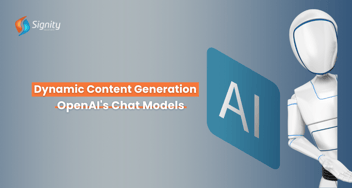Building A Content Recommendation Engine with OpenAI's API
This summary describes the process of creating a content recommendation engine using OpenAI's API. The engine utilizes OpenAI's powerful technology to provide personalized content suggestions, enhancing user experiences and engagement on websites and applications.

In the era of information abundance, content recommendation engines have become a vital tool for enhancing user engagement and satisfaction across digital platforms. OpenAI's powerful language models, such as GPT-3 and its successors, have opened up exciting possibilities for generative AI development and building advanced recommendation systems. In this article, we will explore how to construct a content recommendation engine using OpenAI's API, providing step-by-step technical implementations and examples.
Understanding the OpenAI API
OpenAI's API offers access to state-of-the-art language models that can be used for a wide range of natural language processing tasks, including content recommendation. The following steps outline the process of building a recommendation engine with the OpenAI API:
1. Set Up Your Environment
Before you can start building a content recommendation engine, you'll need to set up your development environment. Ensure you have Python installed, and create an OpenAI account to obtain your API key.
2. Install the Required Libraries
To interact with the OpenAI API, you'll need the `openai` Python library.
3. Collect Data
Content recommendation engines require a dataset of user interactions or preferences. Depending on your platform, this dataset may include user clicks, likes, or ratings on content items.
4. Preprocess the Data
Prepare your data by cleaning, transforming, and structuring it in a way that is compatible with the OpenAI API. For instance, you may need to create user profiles or item descriptions in a suitable format.
5. Define the Recommendation Task
Decide how you want to use the OpenAI model to generate recommendations. You can choose from two primary approaches:
a. Query-Based Recommendations: Users input queries, and the model generates recommendations based on these queries.
b. Context-Based Recommendations: Users provide context, and the model generates recommendations based on the context provided.
6. Interact with the OpenAI API
Use your API key to connect to the OpenAI API and send requests for content recommendations. You'll typically use the `openai.Completion.create()` method to generate recommendations.
Technical Implementation - Query-Based Recommendations
Let's dive into the technical implementation of a query-based content recommendation engine using OpenAI's API:
1. Data Preparation
Suppose you have a dataset of movie ratings and user reviews. You can structure this data into a format suitable for the OpenAI API. For example:
2. API Interaction
Use the OpenAI API to generate recommendations based on the user query. For instance:
3. Display Recommendations
Present the generated recommendations to the user. For example:
Technical Implementation - Context-Based Recommendations
Now, let's explore the technical implementation of a context-based content recommendation engine using OpenAI's API:
1. Data Preparation
Suppose you have a content platform where users provide context in the form of textual descriptions. For example:
2. API Interaction
Use the OpenAI API to generate recommendations based on the user context. For instance:
3. Display Recommendations
Present the generated recommendations to the user. For example:
Conclusion
Building a content recommendation engine with OpenAI's API empowers you to create personalized and context-aware recommendations that enhance user engagement.
Ready to Explore More About Our Solutions?
Get custom solutions, recommendations, estimates, confidentiality & same day response guaranteed!
Whether you opt for query-based or context-based recommendations, the combination of your data, the OpenAI model, and the technical implementation can deliver valuable suggestions to your users. As you fine-tune your recommendation system and explore more sophisticated models, you can continuously improve the user experience on your digital platform.


%201-1.webp?width=148&height=74&name=our%20work%20(2)%201-1.webp)


.png?width=344&height=101&name=Mask%20group%20(5).png)
















